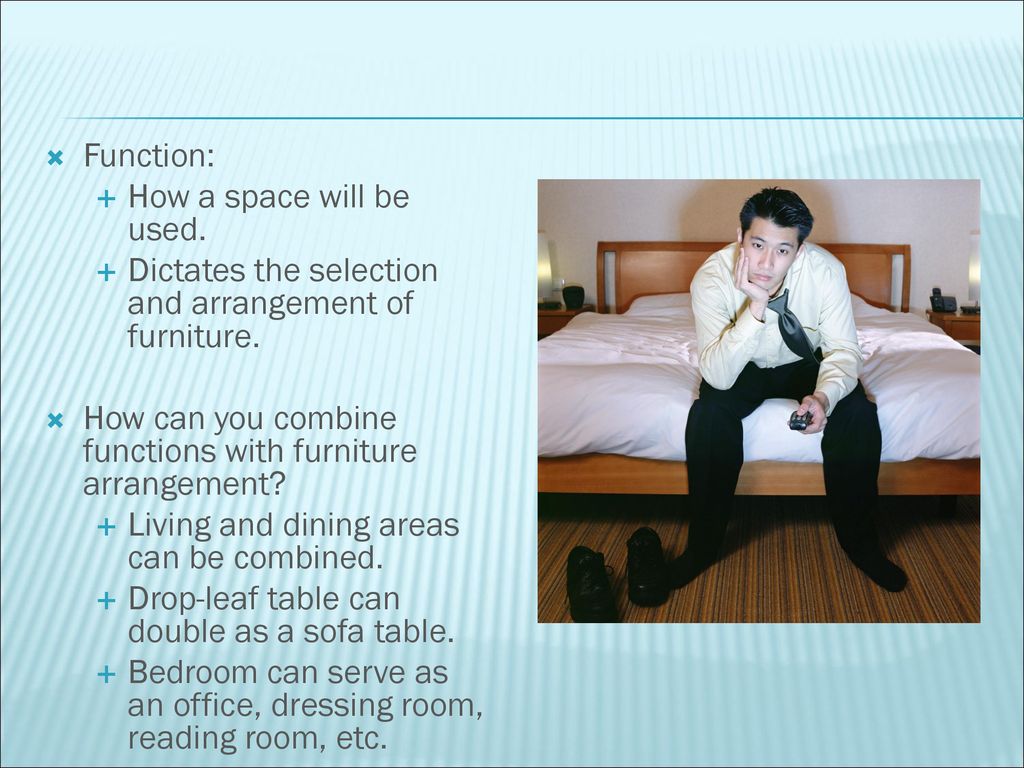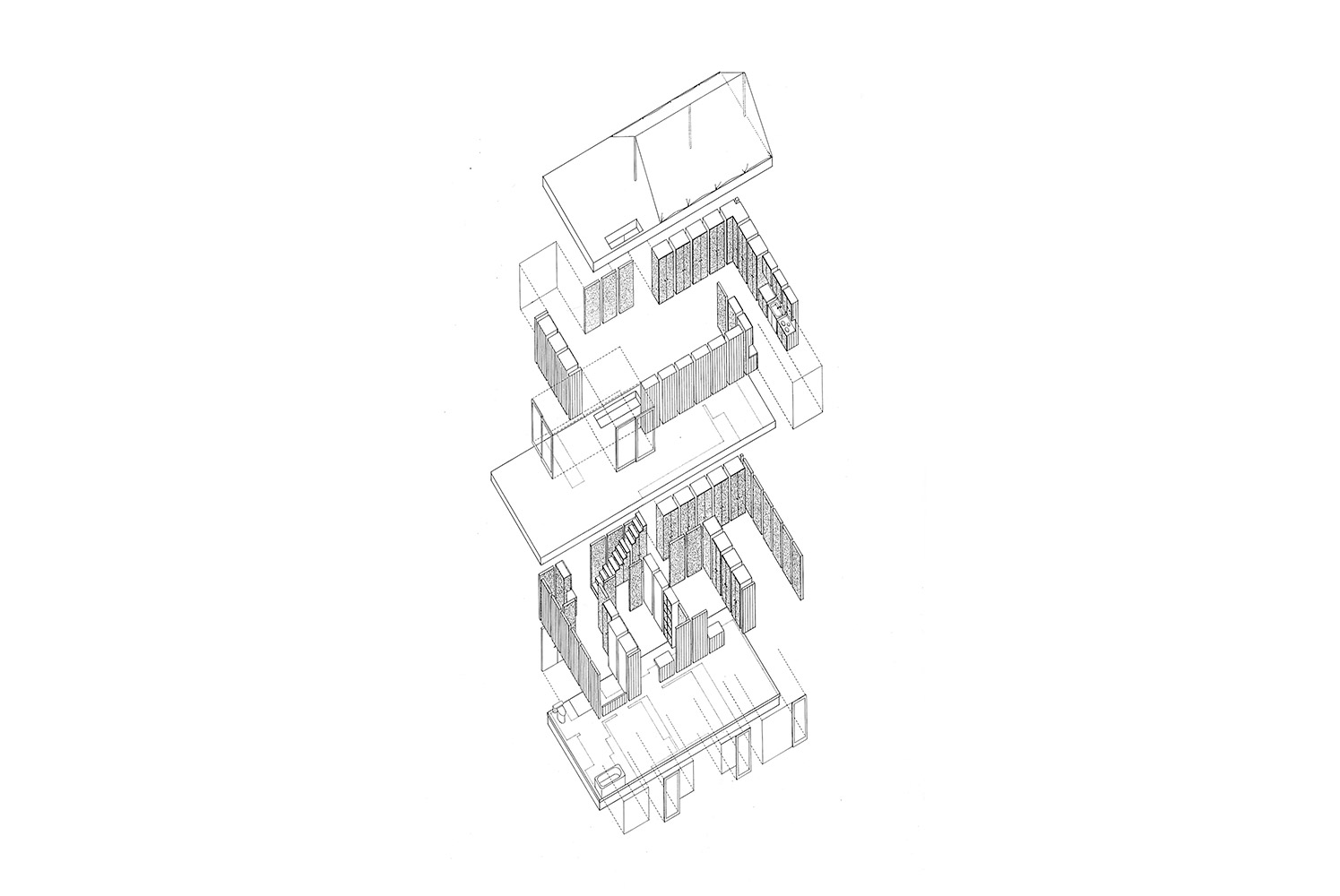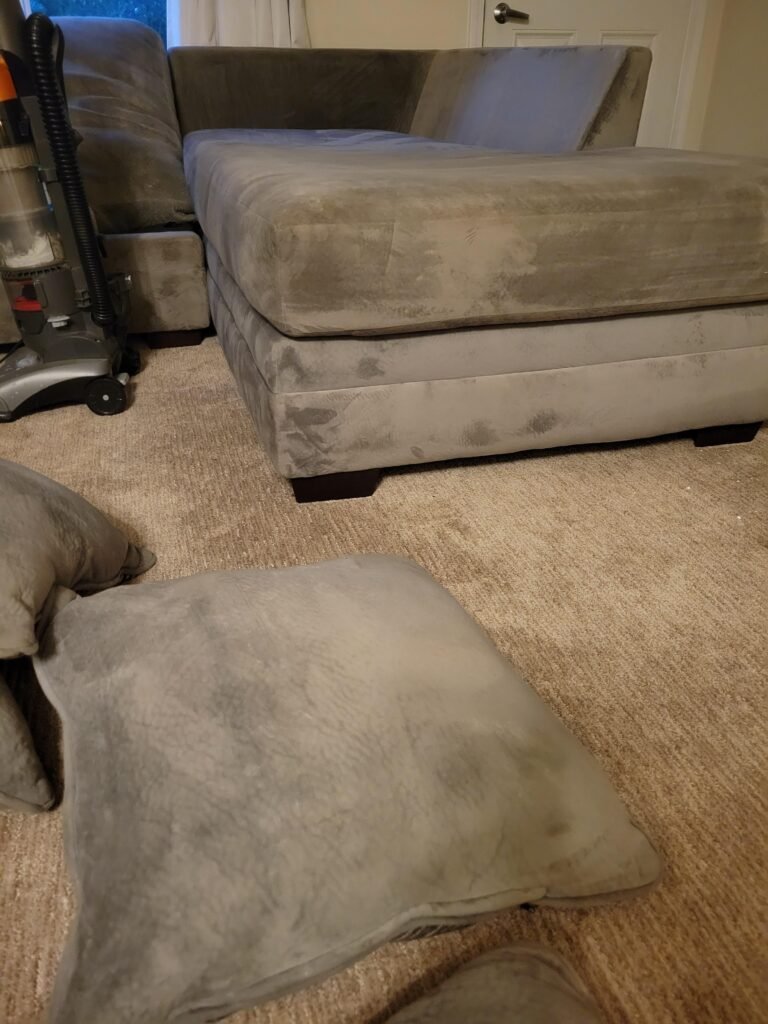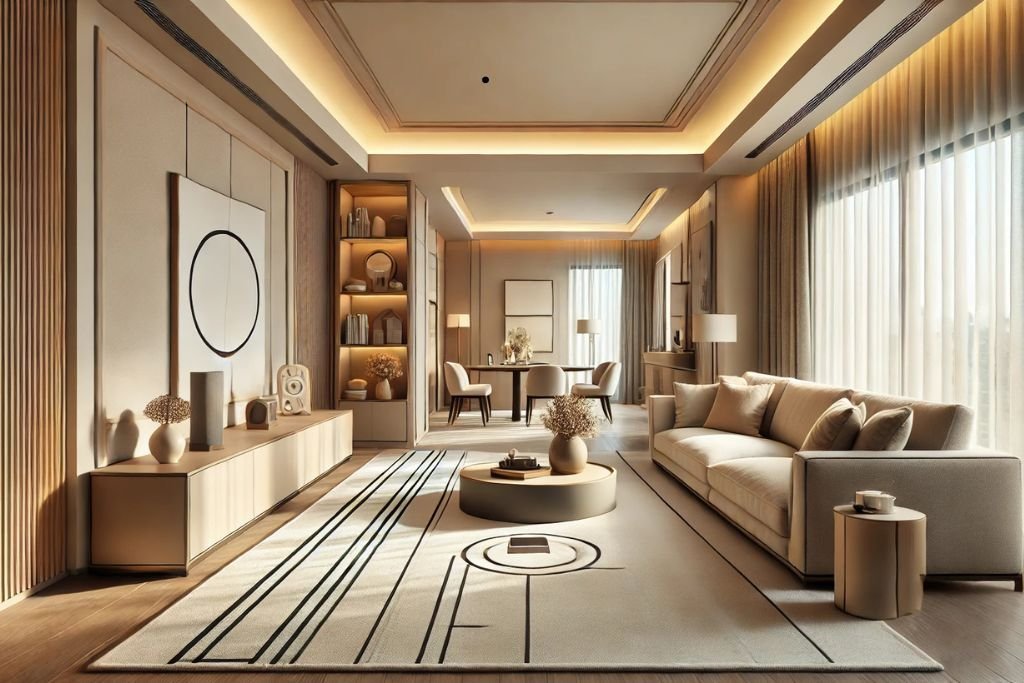As an Amazon Associate I earn from qualifying purchases.
Combining functions with furniture arrangement can be a game-changer for your home. It allows you to make the most of your space while keeping it stylish and practical.
Do you struggle with clutter or feel your rooms lack purpose? Mixing function and furniture can solve these problems. You can create areas that serve multiple roles, like a dining table that doubles as a workspace. This approach not only saves space but also makes your home more versatile.
Imagine a living room where every piece of furniture has a role. It makes life easier and your space more enjoyable. Ready to transform your home? Let’s dive into the smart ways to blend function with furniture arrangement.

Credit: slideplayer.com
Maximizing Small Spaces
Maximizing small spaces can be a real challenge. But with smart furniture arrangement, you can turn even the tiniest room into a functional and stylish area. The key is to combine functions with furniture placement. This way, each piece serves more than one purpose, saving space and enhancing utility.
Choosing Multi-functional Furniture
Multi-functional furniture pieces are a great way to save space. Look for items that serve more than one purpose. For example, a sofa bed can be both a seating area and a guest bed. A coffee table with storage can hold books, magazines, or other small items. This reduces the need for extra furniture.
Consider using ottomans that can double as storage bins. They provide seating and hidden storage. Folding chairs and tables are other good options. You can store them away when not needed, freeing up space.
Vertical Storage Solutions
Vertical storage is a lifesaver in small spaces. Use shelves that go up to the ceiling. This maximizes wall space and keeps the floor clear. Wall-mounted cabinets and racks can hold kitchenware, books, or decor items. They free up valuable floor space.
Hooks and pegboards are also useful. They can hold bags, keys, or kitchen utensils. This keeps things organized and within easy reach. A hanging organizer on the back of a door can store shoes, accessories, or cleaning supplies.
Creating Functional Zones
Creating functional zones in a room can help maximize its usability. Smart furniture arrangement is key. You can make a space more efficient and aesthetically pleasing. By defining different areas, each zone can serve its purpose well. Here are some ways to achieve that.
Defining Spaces With Rugs
Rugs can define different areas in a room. They add a visual boundary. A rug under a dining table sets it apart from the living space. In a large living room, multiple rugs can create separate zones. One rug for the seating area, another for a reading nook. This method is simple yet effective.
Using Room Dividers Effectively
Room dividers can add privacy and define spaces. They come in various forms like screens, shelves, or curtains. A bookshelf can separate a home office from the living room. It also adds storage space. Curtains can create a cozy sleeping area in a studio apartment. Screens offer flexibility and can be moved as needed. Room dividers are a practical solution for multifunctional spaces.
Balancing Aesthetics And Utility
Creating a living space that blends beauty and function starts with thoughtful furniture arrangement. Prioritize versatile pieces that fit seamlessly into your room’s layout. This approach ensures a harmonious balance between aesthetics and practicality.
Balancing aesthetics and utility in furniture arrangement is key to creating a harmonious space. It involves making sure that each piece of furniture is both beautiful and useful. This balance ensures that your home remains both functional and visually pleasing. ###Incorporating Stylish Storage
Stylish storage solutions are essential. They help to declutter while adding to your décor. Choose storage units that match your home’s style. For instance, a sleek, modern cabinet can hide away items and look elegant. A vintage trunk can serve as both a coffee table and a place to store blankets. Open shelves can display books and decorative items. Use baskets on these shelves for items you want hidden. This keeps the area tidy and attractive. ###Blending Function With Decor
Combining function with decor can enhance your home’s aesthetic appeal. Multi-functional furniture is a great example. A sofa bed offers a place to sit during the day and a bed at night. An ottoman can provide extra seating and storage space. Use decorative pieces that also serve a purpose. For example, a stylish lamp adds light and acts as a statement piece. Wall-mounted desks save space and look modern. They can be folded away when not in use, keeping the room neat. Balancing aesthetics and utility is about making smart choices. Each piece of furniture should serve a purpose while enhancing the room’s overall look. This approach ensures that your home is both beautiful and functional.
Credit: www.theinteriordesigninstitute.com
Optimizing Traffic Flow
Optimizing traffic flow in your home can greatly enhance comfort and functionality. Combining functions with furniture arrangement ensures a smooth, clutter-free pathway. This makes daily activities more enjoyable. Let’s explore how to arrange furniture for easy movement and consider pathways and accessibility.
Arranging Furniture For Easy Movement
Arrange your furniture to create open spaces. This allows for easy movement across the room. Avoid placing large pieces in the middle of pathways. Use smaller, movable items to fill gaps without blocking the flow.
Consider the placement of key furniture pieces. For example, position sofas and chairs against walls. This maximizes open space in the center. Ensure there is enough distance between furniture pieces for people to pass through comfortably.
| Furniture Type | Recommended Placement |
|---|---|
| Sofa | Against the longest wall |
| Coffee Table | Center of seating area, with enough space around |
| Bookshelf | Against a wall, not blocking entrances |
Considering Pathways And Accessibility
Pathways should be clear and direct. Aim for at least 24 inches of space for high-traffic areas. For main pathways, ensure at least 36 inches of clearance. This ensures comfort and accessibility.
Think about accessibility for all household members. If someone uses a wheelchair, ensure there is enough space to move around. Avoid placing furniture that could obstruct the pathway. Use round tables instead of square ones to minimize sharp corners.
- Keep pathways clear of clutter.
- Ensure doorways and entrances are not blocked.
- Use area rugs to define pathways and reduce slips.
When arranging furniture, always think about how people move through the space. Consider the flow from one room to another. This will help you create a functional and inviting home.
Utilizing Nooks And Corners
Utilizing nooks and corners in your home can maximize space. These often-overlooked areas can serve multiple functions, enhancing both style and utility. By creatively using these spaces, you can transform your home into a more functional and inviting place.
Transforming Corners Into Workspaces
Corners can make excellent small workspaces. A corner desk fits perfectly into tight spots. Add some shelves above the desk for extra storage. Use a comfortable chair that fits the space. Good lighting is crucial. Place a lamp or install a wall-mounted light. Keep the area organized to maintain productivity.
Creating Cozy Reading Nooks
A corner can also become a cozy reading nook. Place a comfortable chair or a small sofa. Add a soft throw blanket and some cushions. A small side table can hold your books and a cup of tea. Proper lighting is important here too. A floor lamp or a wall sconce works well. This space can become your perfect retreat for quiet moments.
Adapting To Changing Needs
Adapting to changing needs is essential in modern living spaces. Furniture arrangement plays a key role in this adaptability. Flexible furniture solutions can help make your space versatile and functional. By combining functions with furniture arrangement, you can create a home that meets your evolving needs.
Modular Furniture Options
Modular furniture offers great flexibility. It can be rearranged or expanded based on your requirements. For example, modular sofas can be split into sections to suit different seating needs. Modular shelving can also be adjusted to fit various storage needs. This adaptability makes modular furniture a practical choice for dynamic living spaces.
Flexible Layouts For Different Activities
Creating flexible layouts is another way to adapt to changing needs. You can rearrange furniture to create zones for different activities. For instance, you can set up a work area during the day and a relaxation zone in the evening. Movable furniture pieces like folding tables and chairs can help switch layouts easily. This ensures your space remains functional for various tasks.
Enhancing Comfort And Productivity
Enhancing comfort and productivity in your living or work space is vital. The right furniture arrangement can significantly impact both your wellbeing and efficiency. By combining function with thoughtful design, you create an environment that supports your daily tasks and promotes relaxation.
Ergonomic Furniture Choices
Choosing ergonomic furniture is essential for comfort and productivity. Ergonomic chairs, for example, provide proper lumbar support and reduce strain on your back. Adjustable desks allow you to switch between sitting and standing, which can prevent fatigue.
- Ergonomic chairs with adjustable height and lumbar support
- Standing desks to alternate between sitting and standing
- Footrests to improve posture
- Keyboard trays to maintain a neutral wrist position
These choices help prevent discomfort and long-term health issues, allowing you to focus better and work longer without pain.
Lighting For Different Functions
Lighting plays a crucial role in creating a productive and comfortable environment. Different tasks require different types of lighting. For instance, bright, focused light is ideal for work, while soft, ambient light is better for relaxation.
| Task | Recommended Lighting |
|---|---|
| Working/Studying | Bright, direct light |
| Reading | Warm, focused light |
| Relaxing | Soft, ambient light |
Consider installing adjustable lighting options like dimmer switches. These allow you to control the intensity of light according to your needs. Task lamps with adjustable arms and heads are great for focused work. Floor lamps and wall sconces can provide ambient lighting for a cozy atmosphere.
By making thoughtful furniture and lighting choices, you can create a space that enhances both comfort and productivity. This will make your daily tasks more manageable and your relaxation time more enjoyable.

Credit: shigerubanarchitects.com
Personalizing Your Space
Personalizing your space means making it reflect your unique style. By combining functions with furniture arrangement, you can create a room that is both practical and personal. Here are a few ways to achieve that.
Adding Personal Touches
Small details make a big difference. Adding personal touches can transform a room.
- Use family photos to add warmth and character.
- Display souvenirs from your travels to tell your story.
- Include handmade items to add a unique flair.
These elements make your space feel more like home. They also create a conversation starter for visitors.
Showcasing Hobbies And Interests
Your hobbies and interests can also be part of your decor.
| Hobby/Interest | Furniture Arrangement Idea |
|---|---|
| Reading | Create a cozy reading nook with a comfy chair and bookshelf. |
| Music | Display your instruments and vinyl records on shelves. |
| Art | Hang your paintings or sculptures in a dedicated gallery wall. |
Including these elements showcases what you love. It also makes your space more functional and enjoyable.
Frequently Asked Questions
What Is Functional Furniture Arrangement?
Functional furniture arrangement optimizes space and enhances usability. It ensures each item serves a purpose, providing both comfort and efficiency.
How Can I Maximize Small Spaces?
Use multifunctional furniture, like sofa beds or storage ottomans. Arrange items to create open pathways and utilize vertical space.
What Are The Benefits Of Multifunctional Furniture?
Multifunctional furniture saves space and money. It combines multiple uses in one piece, enhancing both functionality and aesthetics.
How To Choose Furniture For Combined Functions?
Select versatile pieces that fit your needs. Consider items with storage, modular designs, or convertible features for flexibility.
Conclusion
Combining functions with furniture arrangement creates a balanced, functional space. It maximizes your room’s potential and helps you stay organized. Think about your needs and choose multi-functional furniture. This approach saves space and adds versatility. Experiment with different layouts. See what works best for you.
Remember, a well-arranged room enhances comfort and productivity. Keep things simple. Enjoy your organized and stylish home.
As an Amazon Associate, I earn from qualifying purchases.


